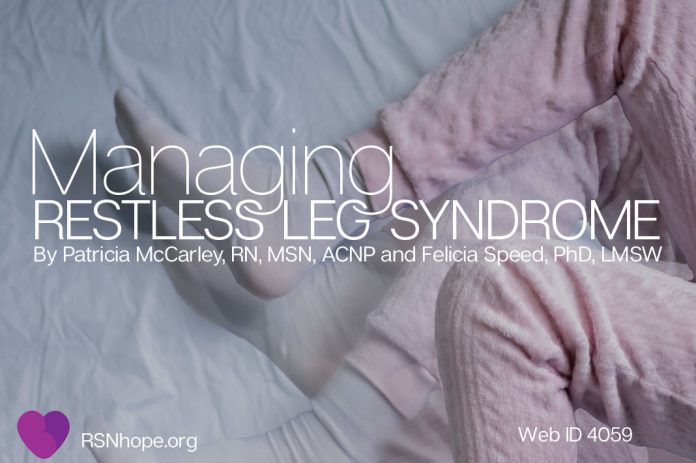Many people who are on dialysis report feeling an uncomfortable sensation in their legs during treatments and when trying to sleep. This sensation can range from mildly uncomfortable to disturbing to the point where it is difficult to sit still during dialysis and difficult to fall asleep.
This medical condition is called Restless Leg Syndrome (RLS), also known as Willis-Ekbom disease, an intense and irresistible urge to move your legs while resting, lying down, or even receiving dialysis treatments. People with RLS often describe it as a “tingling” or “creeping” sensation in the legs. RLS affects 5% to 10% of the general population, but the prevalence of this condition in patients with chronic kidney disease (CKD) ranges from 20% to 73%. The condition tends to worsen as people age.
So, why does this happen?
Diabetes can be one contributing factor to RLS. Diabetes can cause damage to the nerves of the lower legs and feet, which leads to a condition called peripheral neuropathy, a nerve disorder.
Another cause of RLS is iron deficiency, which people on dialysis often experience. Iron stores decrease in your body due to the loss of red blood cells during dialysis. Anemia, a condition in which one lacks enough healthy red blood cells to carry adequate oxygen to their body’s tissues, is common in patients with CKD and almost universal in patients with end stage renal disease (ESRD). It is also a risk factor for RLS.
There are ways to effectively treat Restless Leg Syndrome and reduce its impact. For example, your doctor may advise you on ways to control your diabetes and recommend treatment for your neuropathy.
Always discuss your symptoms with your care team for any help you need in terms of making it easier for you to sleep. Not everyone’s preferences or circumstances are the same, and we encourage you to work with your care team to find the best solution for you.
There are also self-administered home therapies to maximize your chances of getting a good night’s sleep.
Here are a few ways that may help you to get more sleep despite RLS:
• Go to sleep and wake up at the same time each day. Our bodies thrive off of routine, and following a dedicated sleep schedule can train your body to fall asleep quicker and stay asleep.
• Make changes to your sleep environment. Turn off your phone, television, computer, and any other blue light radiating device about an hour before you go to sleep. Blue light blocks something in our bodies called melatonin, which is a hormone that makes us sleepy. Blue light may make us less drowsy at night which means it takes longer to fall asleep.
• Do some exercise during the day. Spend some time outside each day or have periodic dance breaks – all you need to do is move your body. This will help settle your body down at the end of the day for sleep.
Your care team may also suggest warm baths, massages, cold or warm compresses, and relaxation techniques such as meditation to get your body ready for sleep. While there is no cure for Restless Leg Syndrome, you can effectively reduce its impact through medication and treatment and doing your best to get a good night’s sleep.
 Patricia McCarley, RN, MSN, ACNP has more than 45 years of experience in nephrology nursing practice. Her undergraduate and graduate degrees are from Vanderbilt University. In her role at FMC, she is responsible for developing algorithms to guide best clinical practices. Prior to joining FMC, Tricia worked as a Nephrology Nurse Practitioner. During her career she has worked in multiple clinical roles for different dialysis providers. She has numerous publications and received the ANNA Educator of the Year award in 2008.
Patricia McCarley, RN, MSN, ACNP has more than 45 years of experience in nephrology nursing practice. Her undergraduate and graduate degrees are from Vanderbilt University. In her role at FMC, she is responsible for developing algorithms to guide best clinical practices. Prior to joining FMC, Tricia worked as a Nephrology Nurse Practitioner. During her career she has worked in multiple clinical roles for different dialysis providers. She has numerous publications and received the ANNA Educator of the Year award in 2008.
 Felicia Speed, PhD, LMSW, is the Vice President of Social Work Services for Fresenius Kidney Care, the nation’s leading network of dialysis facilities. She currently provides oversight and guidance to social workers across the country and has been working as a dialysis social worker in various capacities for almost 20 years.
Felicia Speed, PhD, LMSW, is the Vice President of Social Work Services for Fresenius Kidney Care, the nation’s leading network of dialysis facilities. She currently provides oversight and guidance to social workers across the country and has been working as a dialysis social worker in various capacities for almost 20 years.
Web ID 4059







